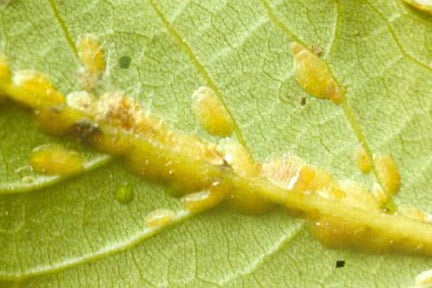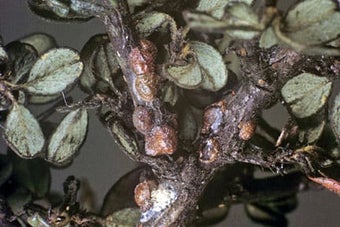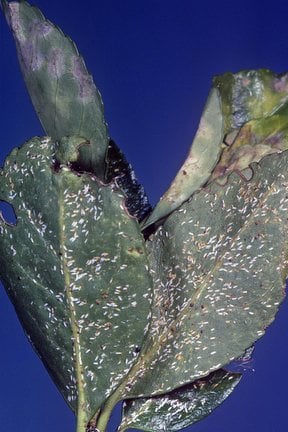
Quick facts
Common name - Scale insects
Scientific name - Various species
Plants affected - Many greenhouse and garden fruits and ornamental plants
Main symptom - Scales on stems and leaves, sooty moulds on foliage
Most active - Year round
What are scale insects?
There many different species of scale insects that can suck the from garden and glasshouse plants in Britain. They range in size from less than 1 mm to over 1 cm in diameter. Many species excrete a sticky, sugary substance, honeydew. Some species also produce white, waxy egg masses on stems or the undersides of leaves, this can be mistaken for mealybug or woolly aphid.
Scale insects can be found on a wide range of ornamental plants, fruit trees and bushes grown out of doors. Several species of scale insects are confined to house-plants, those growing in greenhouses or other sheltered places.
Symptoms
You may see the following symptoms:
- Scales or shell-like bumps on plant stems and the underside of leaves. These are the outer coverings of scale insect
- Large populations may result in poor growth
- Some species of scale insect excrete honeydew, which accumulates on the upper leaf surfaces. This can be colonised by a black non-parasitic fungus known as sooty mould
- Some scale insects deposit their eggs under a covering of white waxy fibres in early summer
Management
If you encounter this insect on indoor plants then please consult our page on indoor plants: sap feeders for indoor specific advice.
- Where possible tolerate populations of scale insects. Well-tended healthy plants are able to tolerate light populations of these insects and so they do not necessarily require management
- Encourage predators in the garden, some ladybirds, parasitoid wasps and some birds will eat scale insects
- Adult scales and egg masses can be removed when seen but this may not reduce large populations
- The nematode Steinernema feltiae can be purchased as a biological control of soft scale and is available from some Biological control suppliers. Nematodes have the potential to infect non-target animals. They should therefore be used with care and only when there is a specific problem to treat
Downloads
Biological control suppliers (downloads pdf)

Biology
More than 25 different species of scale insects can be found in British gardens, these include Pulvinaria, Diaspis, Parthenolecanium, Unaspis, Coccus species and others. They suck from the leaves and stems of their host plants. They are mostly 1-6 mm (less than ¼ in) long, although wisteria scale, Eulecanium excrescens, can be up to 10 mm (about ½ in), and vary in shape and colour.
All species have a shell-like waxy covering over their bodies when mature. The eggs are often laid under the protection of this shell but with the cushion scales (e.g. Pulvinaria species) the eggs are deposited outside the scale under a mass of white waxy fibres.
The adults are sedentary but newly-hatched nymphs are mobile and actively crawl over the plant surface and can help spread the population.
Scale insects in greenhouses can breed continuously throughout the year but those species that occur on outdoor plants mostly have one generation a year.
























